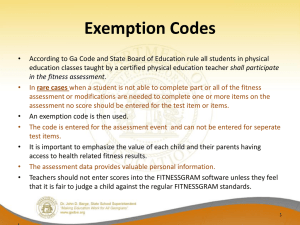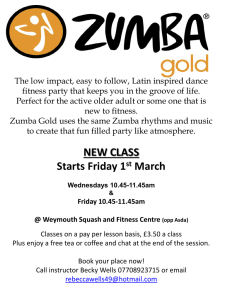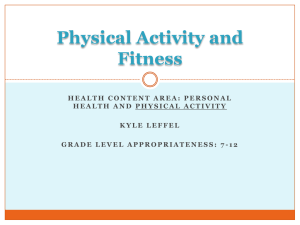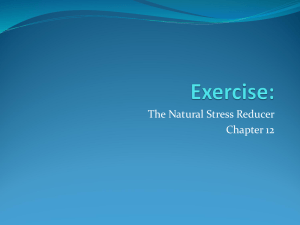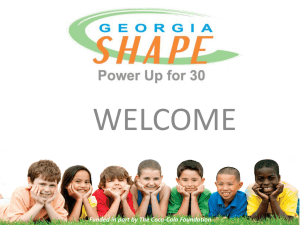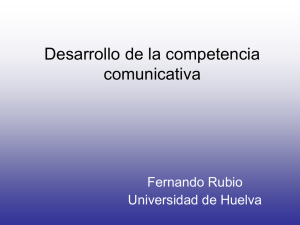Getting Fit
advertisement
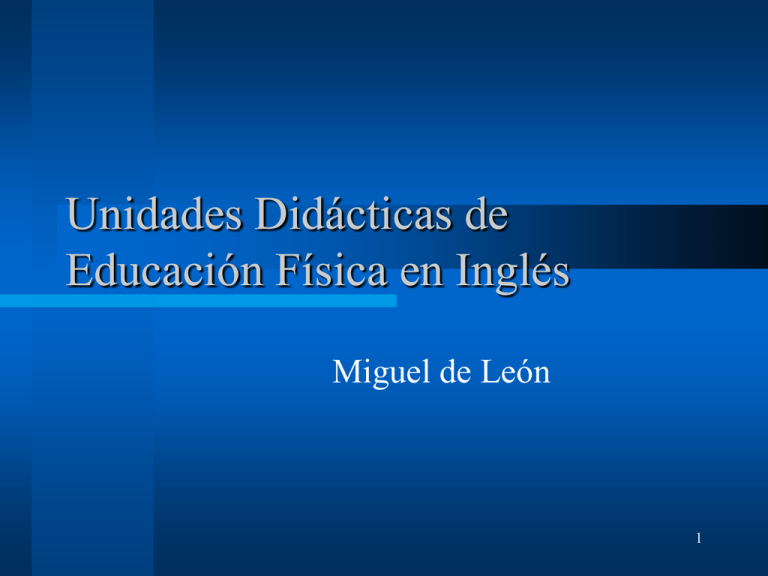
Unidades Didácticas de Educación Física en Inglés Miguel de León 1 Metas del proyecto Diseñar dos unidades didácticas CLIL – Getting Fit (2º ESO) – Keeping Fit (4º ESO) Elaborar materiales – Para el profesor (creación de un “site”) – Para el alumnado Propuesta de evaluación 2 Descripción ¿Qué es un Programa CLIL/AICLE? – aprendizaje integrado de contenido y lengua (extranjera) En Navarra, dos tipos de programa CLIL: – Sección Bilingüe – British Council program 3 Análisis de la situación inicial Centros – IES Alhama Corella (1 año) – IES Toki Ona, Bera (3 años) – IES Valle del Ebro, Tudela (7 años) – IES Benjamín de Tudela (7 años) British program o Sección Bilingüe 4 Fundamentación Normativa – A nivel europeo impulso del plurilingüismo: • Tratados de Maastricht (1992) y Amsterdam (1997). • En1995 “El libro blanco. Enseñanza y aprendizaje. Hacia una sociedad del aprendizaje”. • MCER – En Navarra • La LOE y Real Decreto 1631/2006 • Decreto Foral 25/2007 • Resolución 31/2010 5 Fundamentación Didáctica I ¿Por qué una educación bilingüe? • Motivación hacia un aprendizaje continuado de la lengua • Se optimizan los procesos de aprendizaje de la lengua extranjera al poder aplicar la dimensión emotiva, cognitiva, consciente de L2. • No dificulta el aprendizaje del contenido 6 Fundamentación Didáctica II ¿Por qué la Educación Física en Inglés? • Las posibilidades de expresión no verbal incrementa los recursos comunicativos • La gran variedad de entornos comunicativos facilita el uso diverso y flexible del Inglés. • Proporciona una perspectiva intercultural de mundo recreativo y del deporte • Vinculación entre motricidad y aprendizaje del lenguaje (“Método TPR” de Asher, J.) 7 Fundamentación Didáctica III Metodología CLIL • Diferentes tipos de programa CLIL, diferentes estrategias didácticas • Promoción simultánea de contenido (EF) y lengua • Trabajo cooperativo que conduzca al aprendizaje autónomo: parejas, grupos • Encaminada a desarrollar un repertorio de recursos comunicativos (más allá del vocabulario) que favorezca la dinámica de las sesiones • La utilización de L1 puede ser beneficiosa 8 Fundamentación Didáctica IV Estrategias en EF • Proporcionar un “Input” accesible • Pizarra, posters, pantalla • Demos, ejemplos • Repetir, parafrasear, preguntar, explicaciones entre el alumnado • Lenguaje corporal • “Set up” claro • Sonoridad: voz, espacio, situación respecto al alumnado, altavoces • Interacción • Actividades cooperativas • Agrupaciones variadas (atendiendo al nivel de inglés si es necesario y posible) • Actividades que favorezcan la interacción 9 Fundamentación Didáctica IV Estrategias en EF • En la sesión • Describir objetivos-tareas (oralmente y por escrito) de contenido y lenguaje • Minimizar el tiempo para anuncios, set up, etc • Procurar la participación activa durante el mayor tiempo de clase posible • Ritmo adecuado (alumnado activo y asimilando) • Seguimiento • Proponer actividades diversas para el repaso y valoración de los procesos de enseñanza/aprendizaje • Contextualización de la sesión dentro de la unidad al comienzo de la sesión • Valoración y repaso de recursos clave en el “Cool down” (últimos 3 minutos) 10 Fundamentación Didáctica IV Particularidades comunicativas en EF – Teacher’s Voice: pitch, speed, pause, stress, volume, enunciation will ensure that no words or teaching points are missed. – Gather the students in front of you for a long talk – If you have to talk to a scattered class, check first that students are quiet and attentive – If available, use of a radio microphone in contexts such as: dancing/aerobic, volleyball, basketball, etc. – Gestures and practical examples will help students learn subject-specific terminology. – Reinforce the learning by questions or repetitions. 11 Fundamentación Didáctica IV Estrategias para el fomentar el uso del Inglés en vez de L1 (además de lo ya expuesto) • Acordar reglas que regulen el “Switching Code” en clase • Premiar al alumnado que se esfuerce en utilizar el Inglés • Presentación de trabajos en Inglés • “English Watcher” • “English Leader” • Utilización de las TIC 12 Unidad Didáctica I Getting Fit 2º ESO 13 Getting Fit (2 ESO) • Contexto y Justificación • Ubicación en el programa bilingüe del centro • Aportación al desarrollo del currículo • ESO • Educación Física 14 Getting Fit 1 2 3 4 5 Objetivos CONTENT LANGUAGE Identify what health benefits can be obtained from being physically active and the effects of a sedentary life on health Describe the advantages of being physically active and disadvantages of a sedentary life Keep aerobic workout within the target hear rate by means of heart rate monitoring or pulse check Explain how to calculate the healthy Target Heart Rate Improve the fitness level, specially the aerobic endurance and suppleness, building up exercising and hygienic habits in a challenging and enjoyable context Report physical activities habits and what achievements take place Be aware of posture in daily activities and fitness exercises, avoiding those postures that can damage the body structures. Name and recognize postures or actions that could lead to back injuries or misalignments Participate in fitness related tasks and games, demonstrating team working skills, fair play, courtesy, striving spirit, grace at loosing and winning, and care for equipment and facilities Make an effort to communicate in English with peers and teacher using the appropriate terms to the class scenario 15 Getting Fit Contenidos E.F. 1. KNOWLEDGE 1. 2. 3. 4. 5. 6. Fitness components revision Fitness components for health: aerobic endurance, flexibility and strength Benefits of regular exercising and health consequences of a non-active way of life Aerobic workout: Target Heart Rate: Maximum Heart Rate and heart rate zone for a healthy workout. 1. “Pacing oneself “ 2. What’s good for me? Recommendations for the care of body structures: main muscles and joints 1. Posture when: carrying a backpack, sitting, lifting weights, etc 2. Bodyweight exercises and daily stretches 2. PROCESSES 1. 2. 3. 4. 5. 6. Analysis of fitness components for a lifetime wellbeing Control of the heart rate within the Target Heart Rate in aerobic workouts Participation in different activities which enhance the improvement of the health related fitness components: jogging, tag games and fitness plan. Application of different stretching methods and strengthening exercises as well as warm up and cool down routines, keeping the appropriate body position in each exercise. Use of ITC to get information about fitness and health. Fitness tests: 1 Mile Run Test and Sit and Reach Test 3. HABITS, VALUES AND ATTITUDES 1. 2. 3. 4. 5. A willingness to care for their own well being, demonstrating striving spirit when working out. Acceptance of a variety of performances, no matter how good or poor they are. Critic thinking on a non-active lifestyle Open mind and team working skills in fitness games or group activities, fair play, courtesy, and grace at loosing/winning. Valuing hygienic habits such as: wash or shower at the end of the session, warm up and cool down activities, sport wear, and care for the equipment and facilities. ENRICHED CONTENTS Reactions Do you want to know more? 16 Getting Fit Contenidos Lingüísticos L.1. The language products that students use to describe, explain and report. L.2. Vocabulary for lectures and internet search activities: target heart rate, health, cardio respiratory, spine, etc L.3. Terms for sequences and basic math computations •Firstly, then, after that, etc •Add, multiply, divide, take away, etc L.4. Analysis of tests results and graphs L.5. Use of English in physical activities: •Revision of instructions: “off you go”, “on the jog!” “bring it in”, “time is up”, “pair up”, “Sit down in a circle formation, please” etc •Specific communication skills: •Vocabulary of new equipment, facilities and physical exercises: aerobic exercise, heart rate monitor (watch and transmitter), bodyweight exercises (sit ups, dips, chin ups, push ups, etc), dumbbells, suppleness, body structures (muscles and joints), names of particular exercises or postures, etc •Communication with peers in tag games and jogging assignments: “over here”, “it was close!”, “nice run!”, “She’s fast!”, “watch out!” “IT’s coming!” “this way”, “let’s get John” “I tagged you – you didn’t tag me”, “Who is IT?”, “You ran out of bounds” “Hurry up”, “Catch up”, “to overtake or to go pass …”, “to pace oneself” “To break the record” •Parts of the body and movements. Main muscles and joints. Giving feed-back for a good posture. •Names for bodyweight exercises and stretches. •Whispering, calling out or shouting situation? L.6. Where else is this game played? 17 Getting Fit Resumen del Tipo de Tareas Working out … Aerobic Endurance Tag Games Knowledge Posture Bodyweight Daily Exercises Stretches Lectures Jogging Special Blog session Activities Assessment Tasks, Home Assignments Reinforcing and Enriching tasks Introductory and Summing up tasks 18 Getting Fit TAREAS Map of sessions (see full project) 19 Methodology and Teaching Strategies Getting Fit Presenting new concepts and skills (visuals, Helping students with vocabulary Strategies for supporting reading (i.e. treasure questions, connectors, body language, spanish …) hunt) Strategies for supporting listening (voice, space, mic, questions, repetitions) Strategies for supporting writing (reflections) Strategies for supporting student talk (switching code rules, on the board, grouping, reporting) 20 Getting Fit Methodology and Scaffolding Language Scaffolding – Teaching Strategies – Language processes Content Scaffolding – Aerobic Endurance, Strength, Flexibility – Concept learning – Teaching and learning strategies 21 Methodology and Teacher’s role in the CLIL unit Getting Fit – Planning content and language integrated in fitness sessions – Adapting texts and materials about fitness, being these materials age and level appropriated – Organizing the session components in a way that ensures comprehensible input – Engaging students in using and improving their English. 22 Methodology and Class Management Getting Fit Out of 55 minutes… Activities Space 5’ To get started (travelling and changing clothes time included) Travelling route and lockers 4’ To check attendance, introduce the session and reinforce concepts and skills A previously agreed location in the gym or playing ground (board should be available nearby) 7’ To warm up Gym or Playing ground 32’ To develop core activities Gym or Playing Ground having the students at ear range (if possible) 2’ To cool down and review concepts and skills A previously agreed location in the gym or playing ground (board should be available nearby) 5’ To wash and change clothes (students who wish to have a shower go 5’ earlier to the changing room) Lockers 23 Methods of guidance and types of practice Getting Fit – Cardiovascular endurance is based on verbal and visual methods. Flexibility and strength are mainly conducted by a combination of visual, verbal and mechanical methods – Whole practice, no need of breaking down moves – Fixed practice present in stretches, bodyweight exercises. Tag games leave room for the “Variable practice” 24 Getting Fit • – – – – – – – – – – – – – Resources • Facilities, equipment and materials Gym School Yard Heart Rate Monitors (at least three) Stop Watches Sport Bibs Cones Balls (basket balls or bigger, half the number of students) White Board ICT Classroom Hands out Students’ Portfolio Teacher’s journal book Sit and Reach Box – Internet PE Bilingual Blog: http://bilingualpe2blog.blogspot.co m/. One of the most important links in the blog is “Teens Health” http://kidshealth.org/teen/food_fitne ss/exercise/exercise_wise.html 25 Assessment and Evaluation: WHAT? Getting Fit – Assessment of Learning • • PE content descriptors Language descriptors – Assessment of Teaching (anonymous online rubric) 26 Getting Fit Assessment and Evaluation: How? Assessment tasks Tools Write the physical activities you complete every day Portfolio (Physical Activity Journal, (see Annex 2) Think and write about what you’ve learnt Portfolio (Reflections, see Annex 2) Assessment Tasks Tools Knowledge test Multiple choice test (see Annex 2) 1 Mile Run Test 1 Mile Run test procedure (see Annex 1) In a flat running track, marking cones, recording sheets, stop watch. Sit and Reach flexibility test Sit and Reach Box and recording sheets Treasure Hunt outcome Treasure Hunt report Attendance Sport Wear Work rate Fitness Achievements Wash or Shower Observation of Teacher’s journal Attitudes (Striving spirit, Courtesy, Cooperation, Team working skills) Care of facilities, equipment and materials Use of English/L1 Rubric of English use in the P.E. classes (see Annex 1) and Vocabulary Log 27 Assessment and Evaluation: WHEN? Getting Fit • Initial Assessment The fitness tests, a questionnaire and observation of kids’ attitudes and responses. • Assessment FOR Learning, ongoing assessment or formative assessment Continuous feed-back is provided, either by teacher or by peers. They track their own progress by keeping the physical activity journal and the portfolio up to date. • Assessment OF Learning, summative assessment Have they moved to point “B”? The tasks are: a multiple choice test, the fitness tests, the portfolio hand-in, the Treasure Hunt hand-in. 28 Getting Fit Weight on the Unit Grade Assessment Item 10% Multiple Choice Test 5% Assessment and Evaluation: Scoring Content Weight Language Weight Unit standard Key Competency(1) 100% 0% 9.C.1 9.C.2 1,6 20% 9.C.1 9.C.2 9.C.6 9.L.2 9.L.4 1,2,3,4,6,7 9.C.1 9.C.2 9.C.4 9.L.1 9:L.4 9.L.5 1,3,4,6,7 Subitem Treasure Hunt 80% Physical Activity Journal (10%) 20% Portfolio Aerobic Zone Assignment (5%) 80% 20% Vocabulary Log and Reflections (5%) 10% 1 Mile Run Test 100% 0% 9.C.3 1 10% Sit and Reach Test and Posture assessment 100% 0% 9.C.3 1,6 5% Rubric of English use in P.E. classes 0% 100% 9.L.3 2,3 100% 0% 9.C.4 9.C.5 9.C.6 1,2,4,5,6,7 Wash-Shower 5% Work rate and achievements 10% 40% Teacher's journal Striving spirit, Courtesy, Cooperation, Team working skills 10% Sport wear and classroom materials 10% Care of Equipment and Facilities 5% 29 Average 80% 20% Getting Fit Assessment and Evaluation: Scoring prerequisites and recovering the unit credit • • Attendance, assignments hand in, 3 out of 10 rule. Depending on what unit standards the student didn’t achieve, he or she will receive further support on that component of the unit framework. 30 Getting Fit – – – – – – – Key Competencies Competencia en el conocimiento y la interacción con el mundo físico. Competencia social y ciudadana Competencia en comunicación lingüística. Tratamiento de la información y competencia digital Competencia matemática Competencia de aprender a aprender Autonomía e iniciativa personal 31 Asessment of the Key Competencies Getting Fit – To measure it, I relate the assessment tools and tasks to the competency descriptors. I assign a weight for each item affecting a certain key competency. Consequently I report: • Competencies Rating Scale – – – No meets: the student hasn’t met the competency (0 to 3,5) Needs improvement: the student has barely met the competencies descriptors (3,5 - 6) Meets: the student has successfully met the competency (6 - 10) 32 Getting Fit – Cross curricular work PE and English Departments: • Information trade: – – – • Cooperate in: – – – – Students´ level of English Specific content demands of English in the unit Quality of resources that students will be handling (adaptations) Developing the communication skills to meet language demands of the unit. Building materials Revising assessment procedures (language assessment) Other Departments that might be involved: Science, Maths and Technology (computer skills) 33 CONTENTS LEARNING OBJECTIVES TASKS (session number) LEARNING UNIT KEY COMPETENCIES ACHIEVEMENTS ASSESSMENT PE ESPECIFIC LANGUAGE 4.1.1 4.1.2 4.1.3 4.2.1 L1 L2 5.1.3 (1) 5.2.1 (all, esp n 4) 5.2.8 (4) 5.2.9 (4) 5.2.10 (4) 5.3.1 (all) 5.4.1 (all) 5.5.2 (4) 5.6.6 (12) 5.6.7 (12) 5.6.8 (11) 5.6.9 (all) 9.C.1 9.C.2 9.L.2 oCompetencia en el conocimiento y la interacción con el mundo físico oTratamiento de la información y competencia digital oCompetencia en comunicación lingüísitca oCompetencia de aprender a aprender 4.1.4 4.2.2 4.3.5 L3 L5 5.2.1 (3) 5.2.4(3,5,6, 7,9,12) 5.2.2(3,5,6, 7,9,12) 5.2.10.1 (4) 5.4.1 (4) 5.6.4 (3,5,6,7,9,1 2) 5.6.6 (12) 5.6.10(3,5, 6,7,9) 9.C.4 9.L.1 oCompetencia en el conocimiento y la interacción con el mundo físico oCompetencia matemática oCompetencia en comunicación lingüísitca oTratamiento de la información y competencia digital oCompetencia de aprender a aprender oAutonomía e iniciativa personal 4.2.3 4.2.4 4.2.6 L4 L5 5.2.2(3,5,6, 7,9) 5.2.4(3,5,6, 7,9,12) 5.2.6 (6,7,10) 5.2.5 (all) 5.5.1 (9,10,11) 5.6.2 (2,12) 5.6.3 (1,2,11) 5.6.10 (all) 9.C.3 9.L.5 oCompetencia en el conocimiento y la interacción con el mundo físico oCompetencia matemática oCompetencia en comunicación lingüísitca oTratamiento de la información y competencia digital 5.2.11 (all, 5.6.5 SUMMARY OF THE UNIT COMPONENTS Getting Fit Identify what health benefits can be obtained from being physically active and the effects of a sedentary life on health Keep aerobic workout within the target heart rate by means of heart rate monitoring or pulse check Improve the fitness level, specially the aerobic endurance and suppleness, building up exercising and hygienic habits in a challenging and enjoyable context 4.1.5 L2 34 9.C.5 oCompetencia en el Getting Fit. Examples of Students’ resources Posture Cards Lifting weights! Right o bending at the knees Wrong o o o keeping the body close to the weight bending at the waist reaching out to lift the weight 35 JOURNAL OF PHYSICAL ACTIVITY Tests Results: 1 Mile Run Test Initial:____; Final:_____ Sit and Reach Test Initial:_____cm; Final:______cm Number of Week:_____ Intensity Activity Example Jogging Fitness components involved Duration minutes Aerobic endurance 45 Aerobic Endurance sessions:____ Strength sessions:_____ Flexibility sessions:_____ Hours:____ easy, moderate, challenging (Average Heart Rate?) Moderate, (150 bpm) Supervised by Adult Name Juan Gonzále z Relationshi p and Signature Coach Day 1 Day 2 Day 3 Day 4 Day 5 Day 6 Day 7 Total 36 Getting Fit. Examples of Teacher’s resources 37 Rubric: Use of English in P.E. classes Adapted from http://www.xtec.cat/~jrene5/ (Judith Reñé) Satisfactory grade: total of 20 or up Name: Year: ORAL PRODUCTION 0 1 2 3 4 Does the student say sentences in English? Does the student use the expressions given by the teacher to use in the class? Does the student make an effort to speak in English? Does the student use the vocabulary related to the equipment and the name of the actions and movements that he/she usually performs during the lessons. ORAL COMPREHENSION Can the student understand the teacher's explanations or instructions? Does the student make an effort to understand messages in English? Can the student understand his/her classmates when they speak in English? READING COMPREHENSION Can the student understand the meaning of the expressions given by the teacher to use in the class? Can the student understand the hands out given in class? OVERALL USE OF ENGLISH Can the student follow the physical education class without any special support? TARGETS: 0: never 1: few times 2 sometimes 3: very often 4: always 38 Spreadsheet for Unit Scoring STUDENTS 2 CONCEPTS AND LANGUAGE USE Unit: Getting Fit E P T H Asier 3 3,5 4 E FITNESS TESTS SCORE * WORK RATE, HABITS AND ATTITUDES E U C TOT AL 1M R SR TOT AL W H W R A T SP W CE F TOT AL 8 1,6 4 3 0,70 8 8 8 9 10 3,40 0,00 0,00 0,00 0,00 0,00 0,00 0,00 0,00 0,00 0,00 0,00 0,00 5,70 Key Competencies CC M CS C C L C TI C M CA A CI P NI M NI N M NI NI NI Exam P Portfolio TH Treasure Hunt EUC English use in class 1MR 1 mile run test S-R Sit and Reach test WH Wash or shower NM: no meets NI: Needs Improvement M: meets 39 INTERNET resources Getting Fit and Keeping Fit CLIL Units Blog (students) 2º ESO http://bilingualpe2blog.blogspot.com/ 4º ESO http://bilingualpe4blog.blogspot.com/ PE Site (teachers) https://sites.google.com/site/bilingualphysicaleducation/peteachers-support-area (ver Con el Departamento de Inglés, Glossary of School Terms) 40


